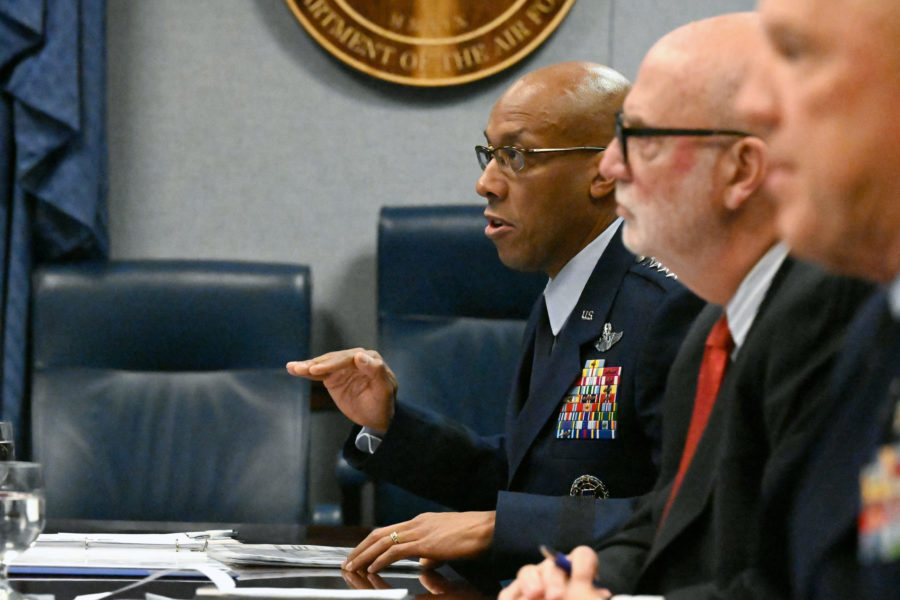To ensure it can compete—and win—against peer adversaries such as China and Russia in the future, the Air Force must divest its aging equipment and instead invest in more capable and advanced aircraft, said Lt. Gen. S. Clinton Hinote, deputy chief of staff for strategy, integration, and requirements.
The challenge is convincing Congress to give up aircraft today for something else later on, something lawmakers have consistently resisted in the past. Hinote said during a May 13 interview with Air Force Magazine editors that the idea of “swapping iron for iron” comes up in every discussion the USAF has on Capitol Hill, but that this time the argument will be more convincing.
“We think we see a change in the debate, in the conversation, when it comes to the willingness of Congress as a whole,” he said. “I’m not talking about Congress as the individual [advocate for] a district or a base or a platform—but we think we see movement in Congress, as a whole, to contemplate getting rid of some things we really like so that we can get to the new tools that our Airmen need.”
Hinote cited two recent examples:
- An April 5 letter from 14 members of the House of Representatives to Defense Secretary Lloyd J. Austin III that called out combatant commanders’ insatiable request for forces, saying, “We have serious concerns that these near limitless [requests for forces] are driving readiness costs to unsustainable levels, servicemembers and platforms are getting burned through at breakneck paces, and much-needed modernization efforts are getting delayed as restricted funds are directed to addressing short-term requirements and risks.”
The congressmen praised the service Chiefs’ “plans to modernize and revolutionize their respective services,” but added, “We fear, however, our ability to modernize the services for future great powers competition and conflict will be undermined by the COCOM’s failure, unwillingness, or inability to make do with their approved [Global Force Management Plan].” - The 2020 final report from the Future of Defense Task Force. “If you look at it, it clearly has this message of, ‘Let’s get to the new so that we can buy down the future risk,’” Hinote said. Deputy Defense Secretary Kathleen H. Hicks has acknowledged the need to balance short-term and long-term risk.
Still, it’s not going to be an easy road.
Air Force Chief of Staff Gen. Charles Q. Brown Jr. caught many by surprise May 13 when he announced the service’s intent to reduce its seven-fighter fleet over the coming 15 years to “four plus one,” with the one being the A-10. Under the plan, the Air Force would begin to retire its fifth-generation F-22 in the 2030s, by which time it could begin to acquire the Next-Generation Air Dominance aircraft. In the meantime, Hinote said, the Air Force will continue to maintain and upgrade the F-22 as a bridge to NGAD but not invest in overhauls that would extend its life beyond 25-30 years.
MacKenzie Eaglen, a resident fellow at the American Enterprise Institute, told Air Force Magazine Brown’s plan “makes tremendous sense.”
For “the past two decades, the operations and support costs tail has outpaced new equipment purchases by two to one,” she said. But the plan “also is a big bet on NGAD and the future of autonomous, semi-crewed and uncrewed systems.”
Eaglen said the Air Force has for decades retired fighter aircraft “far faster” than it could replace them, a track record that’s likely to give Congress pause. “Congress will not accept the promise of two birds in the bush over one in the hand,” she said. “NGAD simply must deliver on time and in sufficient quantity for this goal to become a reality.”
Hinote believes it will. He said he can’t wait for classification levels to ease so he can brag about the highly secretive program. The Air Force has brought several leading lawmakers and Department of Defense officials to see the aircraft and to talk to the Airmen who are flying it. “It’s made a big difference,” he said. “Seeing is believing.”
Rep. Anthony Brown (D-Maryland), a member of the House Armed Services Committee and an Army veteran, said at a May 13 Center for Strategic and International Studies event that the Air Force must clearly explain its reasoning and provide the analysis that backs it up.
Many lawmakers were caught off guard and “confused” by the service’s decision to acquire up to 144 F-15EX fighters, he said, a plane the Air Force says it needs to replace rapidly deteriorating F-15Cs. As a “big believer in the F-35,” Brown said he can see a role for the Eagle II, but “they’ve got to be as open and transparent [as possible] to make their case to Congress, whether they want to retire a system or whether they want to, you know, modernize and move to another platform.”
Eric Fanning, the former Pentagon official who now leads the Aerospace Industries Association, said the cut-now-to-buy-later strategy is always hard to execute.
“This sort of becomes a self-fulfilling prophecy in a way,” he said. “The longer you go with that gap … the worse it becomes, year after year after year, because the existing fleet can become increasingly expensive to maintain, to modernize, [until you get] to a point where you can’t SLEP it anymore.” (A SLEP is a service-life extension program.)
The Air Force can’t continually “kick a bigger problem down the road,” he said. “You know, modernization is future readiness, and what’s our readiness posture going to be in the future if we don’t figure out how to bridge these gaps?”

